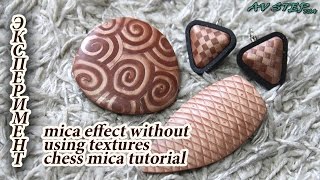Friday, 26 December, 2025г.
















Где искать: по сайтам Запорожской области, статьи, видео ролики
пример: покупка автомобиля в Запорожье
Mica Shift technique polymer clay tutorial 084
I have created this polymer clay tutorial on how to obtain mica shift in polymer clay specially for beginners in the polymer clay world. I tried to explain why the phenomenon happens, and give you not just a more-depth insight on the "why" and the "how" of this technique but also give you a few tips on how to achieve a good mica shift effect.
This technique was initially taught by Mike Buesseler in the 1990s. The technique was then perfected by other artists, of which the most notable one is Dan Kormier. There can still be found online many tutorials on pcpolyzine dating 2000-2001.
If you just discovered my channel, don't forget to like, subscribe and share with your friends!
I make these free tutorials to encourage people to discover their inner artist, and to grow and develop their innate abilities to create beauty.
Please check the playlists tab on my channel page, as I have organized my videos in a way that would make it easier for you to find what you are looking for. With over 600 videos to date it can be quite challenging to look for something. Also, check my website, where I have more information neatly organized.
Check the community tab on my channel page as well, I post updates there all the time.
I buy my Premo, Fimo and Pardo clays and many other supplies from PolyClay Play.
https://polyclayplay.com/?aff=2
If you have any questions, suggestions or requests, either post here on my channel under the "community" tab or contact me through my website or Facebook page.
My website: https://www.kalyanadesign.com
My facebook page: https://www.facebook.com/kalyanadesigntutorials/
My Pinterest page:https://www.pinterest.com/kalyanadesign/
My blog: http://kalyanadesign.blogspot.com/
You can find out how you can support me to make more tutorials and keeping my channel ad-free, here: https://bit.ly/2HtVNmC
Disclaimer: this video description and possibly some narration in the video contain affiliate links. If you click them and purchase something, I will get a small percentage revenue. As I explained above, it helps me with the costs needed to make these free tutorials. But, unless specially indicated in the video/video description, I do not specifically promote those products over others, and usually I give alternatives and most of the time I give alternatives.
Notice of copyright:
Please feel free to use the design/technique presented in this video for your own personal use or for making various items to sell. That is what tutorials are for, after all.
Mentioning of the author is desired and appreciated, but not mandatory.
Different than other artists, I will tell you: do exactly what I do in the tutorial, until you are able to do it exactly how I do it. That means you will have mastered the technique and you will be able to start tweaking it and putting your personal touch to it and grow as an artist.
Just please do not copy the tutorial itself and don't present as yours my techniques. It might not be illegal but it's not ethical.
And remember, I love seeing photos of what you did using my tutorials, and if you send some to me, I will feature them on the Kalyana facebook page!
I use music almost solely from the composers listed below .
Intro: "Hey!" by Benjamin Tissot (http://www.bensound.com)
Licensed under Creative Commons:
By Attribution 4.0 License
http://creativecommons.org/licenses/by/4.0/
Rest of the video: Music by Kevin MacLeod (incompetech.com) (listed at the end of the video)
Licensed under Creative Commons:
By Attribution 3.0 License
http://creativecommons.org/licenses/by/3.0/
Теги:
best polymer clay tutorial mica shift technique polymer clay tutorial polymer clay mica shift best mica shift clay how to make mica shift best mica shift tutorial mica shift shaving blade polymer clay surface effects kalyana design polymer clay ideas
Похожие видео
Мой аккаунт


 У вашего броузера проблема в совместимости с HTML5
У вашего броузера проблема в совместимости с HTML5


